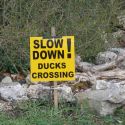The (Follow Me) bus picks us up at the green statue, the statue of the patron saint Vicente de Albufeira, along with a young couple from St Vicente Hotel. Surprised to find the bus, which probably seats 80, is almost full. The young couple are stuck in the back width-of-the-bus row. The tour is in English, French and German, with the guide switching fluently. So out past what I take for tall, sweeping mimosas but turn out to be luxuriantly golden acacias. Also olives, grape vines and orange groves. The oranges aren't native to Portugal, nor are the acacias or the ubiquitous eucalyptus (both from Australia) but the figs and almonds are.
Then up into the hills to Silves, the old Moorish capital. There's a cathedral and a castle (dark red like the iron rich local soil). Would have liked to go in the castle, but apart from the admittedly modest entry fee (€2.50, or €1.25 for the retired) there's a queue and we're not really here long enough to waste it all standing in line. The castle is at the top of a roughly cobbled road leading past buildings with nice 18th century iron work balconies. The settlement is much older than that. Both Romans and Phoenicians mined the iron and copper rich area, but very few buildings date from before 1755, the year of Portugal's massively destructive earthquake. There is a second century bridge though, a small Roman arch across the river still used by pedestrians. And halfway up the hill there are storks' nests, at least one clearly occupied by a nesting bird with young to feed. The nests are huge and look quite capable of holding human infants.
And further up into the mountains to Monchique. It's too cloudy, almost foggy, for good views here. There's an over-organised stop for wine tasting though - choice of port, a fairly uncomplex almond liqueur, wine or the local "fire water" (read schnapps?) all in glasses not much bigger than a toothpaste cap - moving right along, there are 80 people filing through in ten minutes. The shop is actually quite interesting, with heavy handmade cardigans and ponchos (€25 to €30 - can't be a great deal more than the price of the wool) as well as colourful tiles and various things like trivets made from the local cork. We've passed quite a few cork oak trees, many of them "naked" to the branching point as the outer bark, the cork, has already been harvested, hacked off in sheets an inch and a half thick or more. This is quite sustainable, and in fact the forests are ecologically valuable. The cork is harvested every nine years and the tree thrives, with the protection of its substantial second inner bark. In the air is the scent of smoke from the cork processing plant. Our lunch stop is in the mountains. J and I pass on the arranged meal and picnic near a stone wall, watching a man nearby working on his garden and listening to a rooster's call by the side of a quiet road.
After lunch is Lagos, with its protected harbour full of yachts. It's nice but somehow seems a little more cosmetised than "our" old town. Funny how any place we've stayed in and done our own cooking we feel like we've lived in - e.g. Rhodes, Krakow, Albufeira - whereas places we may have stayed in for as long or longer, such as Sousse or Bangkok, we feel we've only visited. Lagos has lots of little restaurants and shops, including more with the heavy Portuguese sweaters. This is an historic city - explorers sailed from here to the new world in Portugal's golden age. In the centre of the town there's a spot that once was a slave market. Indeed a dark skinned woman walks slowly past with a large basked balanced perfectly on her head. Not by chance, though, as she stops for coins from the first of our number to step forward with his camera.
We go past Sagres, now a surfing centre but historically home to a navigation school. At the photo op stop one man loses his camera, so the coach turns back - fortunately only a couple of minutes on. One of the other passengers finds the camera in the long grass, amid cheers by the rest of us. Last stop is Cape St Vincent, the southwest corner of Europe. On one side of the lighthouse - second strongest lighthouse light in the world - the Atlantic leads to Africa, on the other side to the Americas. The cliffs are formidable. A few men can be seen fishing from craggy ledges. Not a spot where one would wish to do battle with a fish with any fight to him, and apparently fishermen are occasionally lost here.
It would have been nice to have stopped at Portimao on the way back, but it's been a long day. Half past seven when we get home.
